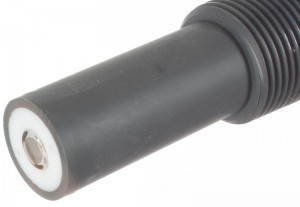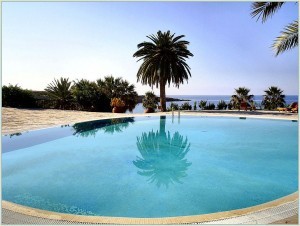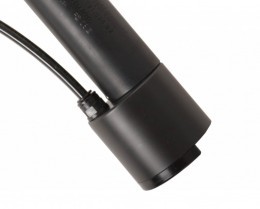The ORPSense range of ORP Meters from Pi utilize the very latest and best ORP sensors available in the world today for measuring the online Redox potential of any aqueous solution. They are platinum ball based sensors with integral reference electrodes which use no reagents, are extremely stable, and have reduced maintenance and reduced whole life costs.
Online ORP meters and ORP controllers are one of the most common analyzers in use today in water treatment and process plants and yet online ORP meters cause continual problems for their operators. What is needed is a stable, reliable, online ORP meter for a reasonable cost. That is exactly what you get with the ORPSense and the ORPSense Automatic Calibrator.
The ORPSense sensors and flow cells are available with different controllers giving you the same great performance with different communication, display, and control options. With the ORPSense range of ORP meters, you get everything that you need – and nothing that you don’t.
The sensor at the heart of the Process Instruments online pH/ORP meter is a patented polymer filled glass electrode. This ORP electrode is far superior to many online process ORP electrodes on the market and is designed for a long life, low drift and high reliability. Unlike many ORP analyzers, you don’t need to search through hundreds of ORP electrodes to find one that works in your process as the ORPSense electrode works in all environments from pH 2 to 12 and in conductivity from 0µS upward. Although they command a higher price in the market place these sensors are more than cost effective with their longer life and considerably lower maintenance requirements, typically only needing calibration once per two or three months. Despite all of the additional functionality that this unit has to offer, the purchase costs are less than or comparable to, its competitors!
The ORPSense ORP monitor takes away the requirement for continual calibration and re-calibration of the ORP meter by operators as it utilizes an extremely stable pH electrode. The ORPSense will calculate a ‘degree of confidence’ in its own calibration and let you know if its confidence is low. If the pH meter detects a fault in the ORP sensor then it gives instructions on the display as to what the fault may be, with full on board fault diagnostics.
The online ORP meter is capable of full PID control and is equipped with process control options, data-logging, relay outputs, serial communications, (TCP, Ethernet, Modbus are available now with Profibus available soon). Remote Access of the ORP meter (including remote access to all control options) is available via the internet, and via a LAN. In fact the ORPSense has all the options you could want in an ORP meter whilst maintaining a low cost and great value for money.
- Stable and reliable ORP meter
- On board diagnostics
- Low purchase cost
- Long life ORP sensors
- Remote access and SMS text alarms
- PID and other process controls
- Remote Sites
- Cooling Towers
- Food Preparation
- Paper Mills
Anywhere you have a requirement to measure ORP is a suitable application for the ORPSense. The ORPSense ORP meter range is particularly suited to working in sites where reliability and ease of use are most important.
As described in a separate brochure, the ORPSense can come equipped to automatically clean itself at user defined intervals with all the benefits of no operator intervention. The Autoflush is particularly useful in food preparation, pulp and paper, and many applications where there is likely to be a build up of solids in the sample.
Get more info on the ORP Monitor
Please contact us by using the form below.
The whole range of ORPSense ORP meters can be fitted with additional sensors such as chlorine or pH. Please ask your local distributor for more details.
| Document | Type | Size |
|---|---|---|
ORPSense |
Brochure | 548kB |
ORP Selection |
Brochure | 545kB |
ORP vs. ppm |
Technical Note | 457kB |
CRONOS® |
Brochure | 582kB |
CRIUS® |
Brochure | 584kB |
CRIUS® Remote Communications |
Brochure | 573kB |
CRONOS® and CRIUS® Control Options |
Technical Note | 534kB |
Remote Access GPRS |
Technical Note | 481kB |
Autoflush |
Brochure | 434kB |
Probe Fouling |
Technical Note | 382kB |
Focus Ons are a series of short articles distributed by email providing technical information regarding instrumentation, process measurement in potable, waste, process and pool waters. If you would like to join the mailing list, please contact us.
Chlorine is often removed from a process and there are a number of potential reasons why. Chlorine might damage an RO membrane or turn food brown in an unsightly manner. Chlorine removal presents several challenges to instrumentation manufacturers and engineers, but…
… did you know that ORP can effectively control sodium bisulphite dosing to remove chlorine?
… did you know that ORP can limit the dose of excess sodium bisulphite which can lead to problems later in the process?
… did you know that ORP is very sensitive to changes in chlorine at very low levels?
How do you effectively control chlorine removal?
Logically, it would be perfectly reasonable to take a standard chlorine probe and dose a reducing agent such as sodium bisulphite until the probe gets to zero. Then if the probe does increase from zero, dose more reducing agent.
Unfortunately due to the inherent electrochemical properties in chlorine sensors, this perfectly logical solution won’t work. This is because amperometric chlorine probes require the presence of some chlorine in order to function properly. This is generally called polarization and the longer a probe has been in water without chlorine, the longer it will take to see chlorine when it is reintroduced. This isn’t due to manufacturing quality or to design flaws. This is a fundamental electrochemical property that is hard to engineer out.
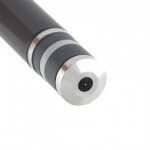 Some amperometric probes are more resistant to this effect than others. They are suitable for applications where chlorine may intermittently reach zero, or where the probe can be periodically reset in chlorinated water (typically potable water). Pi’s HaloSense Zero has been built with this in mind. This amperometric zero chlorine sensor is being successfully used in RO membrane applications and many other low-level chlorine processes.
Some amperometric probes are more resistant to this effect than others. They are suitable for applications where chlorine may intermittently reach zero, or where the probe can be periodically reset in chlorinated water (typically potable water). Pi’s HaloSense Zero has been built with this in mind. This amperometric zero chlorine sensor is being successfully used in RO membrane applications and many other low-level chlorine processes.
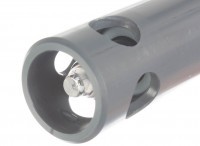 However in applications where reducing agents are used to remove chlorine, a more elegant solution is to use ORP. An ORP sensor measures oxidation reduction potential. The reaction between chlorine and a reducing agent is a reduction-oxidation (redox) reaction. This means that ORP can be used to control this process and can ensure the removal of chlorine, whilst simultaneously preventing the overdosing of a reducing agent.
However in applications where reducing agents are used to remove chlorine, a more elegant solution is to use ORP. An ORP sensor measures oxidation reduction potential. The reaction between chlorine and a reducing agent is a reduction-oxidation (redox) reaction. This means that ORP can be used to control this process and can ensure the removal of chlorine, whilst simultaneously preventing the overdosing of a reducing agent.
Simplified Reaction Between Free Chlorine & Sodium Bisulphite
Below is a simplified example of the reaction between HOCl (free chlorine) and NaHSO3 (sodium bisulphite).
2NAHSO3 + 2HOCl → H2SO4 + 2HCl + Na2SO4
When free chlorine is in excess, the ORP is raised and when sodium bisulphite is in excess, the ORP is lowered.
At low levels, a very small change in the concentration of chlorine will result in a large change in ORP. This is because the relationship between ORP and the concentrations of oxidants and reducing agents is logarithmic. The same also goes for the concentration of reducing agent (such as bisulphite), once an excess has been reached.
The ORPSense from Pi can be used to control chlorine removal. An ORP titration curve is necessary to choose a setpoint for ORP. The graph shows a typical ORP titration curve, though the exact values will be different for each process. It is important to test each new installation and to adjust the ORP setpoint accordingly. Once this titration curve has been determined, there is no continual calibration involved with ORP sensors.
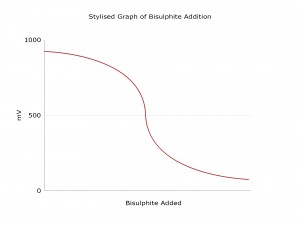 It is worth acknowledging that ORP can be affected by many other variables in the process water, such as conductivity, pH or temperature, and that this method of control won’t be suitable for all processes. Combined with Pi’s CRONOS® or CRIUS® controller, Pi’s ORPSense can be installed alongside other sensors like the zero chlorine sensor, pH or conductivity sensors to help give you a more complete picture of your process.
It is worth acknowledging that ORP can be affected by many other variables in the process water, such as conductivity, pH or temperature, and that this method of control won’t be suitable for all processes. Combined with Pi’s CRONOS® or CRIUS® controller, Pi’s ORPSense can be installed alongside other sensors like the zero chlorine sensor, pH or conductivity sensors to help give you a more complete picture of your process.
If you need to control a process where chlorine is removed with chemicals, a carbon filter or even with UV, Pi can help you by providing world class instrumentation and application expertise.
NB. This Focus On is about the removal of chlorine, however, many principles in this Focus On can be applied to other oxidants such as chlorine dioxide.
You probably know that some instruments use ORP to control chlorine dosing and others use ppm chlorine sensors but…
… did you know that ORP over about 3 ppm won’t work?
… did you know that swimming pools in the USA use ORP and in Europe use ppm chlorine sensors?
… did you know that the ORP of towns water can vary a great deal?
In the USA nearly all pools and spas use ORP sensors to control their chlorine dose, yet conversely in the UK and Western Europe most ORP systems have been replaced with systems that measure the concentration of free chlorine in water. Pi provides systems that utilize either or both technologies.
ORP
Oxidation reduction potential (ORP or REDOX) sensors, measure the tendency of water to gain or lose electrons from anything in the water. The more positive a reading from an ORP the greater the tendency the water has to oxidize (gain electrons from) organisms or other material in the water, thereby killing or destroying them.
Why do so many pools in the USA use ORP?
When chlorine is dosed into a pool it form OCl– and HOCl. Disinfection is largely done by the HOCl and ORP responds to the concentration of HOCl in the water, which makes it a good measure of the tendency of the chlorine in the water to kill bugs. Despite this, ORP is a secondary measure of HOCl and is affected by a multitude of other factors, some of which will be touched on below. The main attractions of ORP are; low purchase cost, no calibration and little or no maintenance.
What are the problems with ORP sensors?
Unfortunately, what ORP sensors measure is tendency and not capacity, i.e. ORP measures the likelihood or the ability of the water to kill bugs, but not how many bugs that water can kill, a subtle but very important difference. A sample with high ORP may be able to kill a small number of bugs very quickly but then not be able to kill future pollution. What’s more, although chlorine affects ORP very strongly it is not the only variable involved. The pH of water affects ORP directly and also affects the concentration ratio of OCl–/HOCl, the two main disinfectant components. A lower pH (higher acidity) will cause an increase in the relative concentrations of HOCl causing an increase in ORP.
Perhaps the biggest issue with ORP is that the ORP readings on water with no chlorine in it will be different depending on the source of that water. This means that an ORP of 750mV in one part of the country is not the same chlorine concentration as 750mV in another part of the country. Also the ORP response to HOCl is not linear and increasing residual chlorine above 3 ppm has little effect on ORP readings making control above 3 ppm extremely difficult. These issues typically lead to overdosing the water with chlorine, in order to compensate for these effects. This can be seen very clearly in US pools which often have more than 2 ppm of chlorine compared to European pools which typically operate around 0.8-1.5 ppm (The World Health Organization recommends 1 ppm residual).
ppm Chlorine
These sensors use electrochemistry to measure the free chlorine concentration directly. They tend to be slightly more expensive than an ORP sensor, but are more reproducible and precise, and therefore tend to give better control (and therefore reduced chemical cost). They are specific to free chlorine (the disinfectant) and can be easily calibrated using a DPD test for free chlorine. Whilst the capital cost for a ppm chlorine sensor is higher, total cost of ownership tends to be lower as ORP sensors are typically replaced every year and ppm sensors last for ten years or more.
Problems with ppm Chlorine sensors
A ppm sensor measures the capacity of water to kill organisms, the only problem is that it doesn’t measure how fast the bugs are killed, a variable largely down to pH. There are two different types of ppm sensors. The first measure only HOCl, and have very similar problems to ORP sensors. The other type of sensor, in pHs below 8.0, measure both HOCl and OCl–. Pi only recommends the use of sensors that (for use in pools) are independent of pH, and the use of pH control that is independent of chlorine dosage. This leads to tighter control of both pH and free chlorine meaning chlorine residuals can be more tightly controlled and reduced, which in turn leads to lower costs and a more pleasant bathing experience.
Conclusion
| Advantages | Disadvantages |
|---|---|
ORP SensorsSimple (no calibration) |
ORP SensorsDoesn’t measure disinfection capacity |
ppm SensorsMeasure free chlorine directly |
ppm SensorsRequires calibration |
Many different sites ranging across the whole water industry have a daily struggle to keep instrumentation functioning correctly due to fouling. However did you know that…
… self cleaning and self flushing systems are now available from Process Instruments for most types of sensors?
… these fouling removal systems can extend the life of sensors and drastically reduce maintenance regimes?
… Pi’s self cleaning/flushing systems are affordable, simple and trouble free by design?
What is the problem?
Sensor Fouling
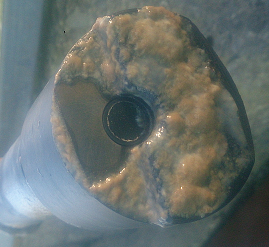 Whatever the process being monitored is, there is often something in the sample water capable of fouling a sensor, and therefore causing erroneous results. The obvious solution to this problem is to clean the sensor, but how regular should inspection and cleaning programs be for each piece of instrumentation? Too regular and the inspection and cleaning regime is time consuming and unnecessarily costly. Not often enough and the instrumentation will give false results and probably fail prematurely.
Whatever the process being monitored is, there is often something in the sample water capable of fouling a sensor, and therefore causing erroneous results. The obvious solution to this problem is to clean the sensor, but how regular should inspection and cleaning programs be for each piece of instrumentation? Too regular and the inspection and cleaning regime is time consuming and unnecessarily costly. Not often enough and the instrumentation will give false results and probably fail prematurely.
Solution: Pi’s Autoclean & Autoflush Systems
Simple, reliable and easy to maintain, Process Instruments’ Autoclean/Autoflush systems are an alternative to mechanical cleaning mechanisms which can clog and break. By regularly spraying the sensor/probe with clean water or air, the sensor remains clean and free from fouling for extended periods of time. The sensor cleaning cycle is activated by Pi’s controller for a user selectable length of time and frequency so that no matter how dirty the application, the probe remains clean. With no moving parts in the sensor body or in the cleaning attachment there is nothing to replace or check other than a simple valve positioned in an easy to reach location.
Pi’s Autoclean and Autoflush systems can give trouble free and fouling free functioning of sensors for weeks, if not months, at a time.
Autoclean
This option can be added to our pH, ORP, Turbidity, Suspended Solids and Dissolved Oxygen (DO) sensors. Consisting of an end cap to direct the flow of clean water (or air for a DO sensor) across the face of the sensor blasting any dirt away. The cleaning is controlled by a single valve positioned in an easily accessible location.
Autoverify
If using air to clean a DO sensor the system can also automatically verify that the sensor is still responding correctly, removing any need to remove the sensor from the sample for months at a time.
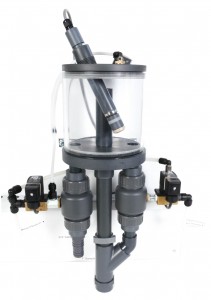
Autoflush
For sensors that require flow cell mounting like Chlorine, Ozone and Chlorine Dioxide, an Autoflush system has inbuilt valves which automatically start/stop the sample flow and control the flow of clean water past the probe. The user can set the flushing interval and duration to keep the flow cell and sensor clear from fouling. For particularly dirty or stubborn contaminants, warm water can be used as the flush water to aid cleaning.
With the above options, whatever the application or parameter being measured, Process Instruments will be able to provide a monitoring system that will not only be accurate, precise and long lasting but that will also remain free from fouling and save the operator both time and money.


































